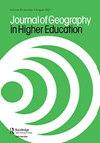GIS在高中的应用能提高大学地理的入学率吗?地理空间学期的影响
IF 1.8
4区 教育学
Q2 EDUCATION & EDUCATIONAL RESEARCH
引用次数: 0
摘要
招收本科生是地理专业面临的一个重大挑战。很少有学生在中学时接触过地理知识,而且这个专业对大一新生的认知度很低。事实上,在许多大学里,地理通常是学生在通识教育课程后选择的一个“发现”专业。但是,一定要这样吗?地理课程能否在建立未来学生的渠道方面发挥更积极的作用,而不仅仅是支持AP人文地理教师?在本文中,我们描述了大学院系建立强大招聘途径的另一种途径,分享了建立联系的成功和挑战,以及学生通过早期接触地理空间技术获得的学习优势。我们专注于地理空间学期,这是詹姆斯麦迪逊大学和弗吉尼亚州(及其他地区)参与的双招生项目,始于2005年。我们将分享各部门如何与高中建立成功的合作伙伴关系,以及在大学环境中维持这样一个项目的过程。我们还将描述我们所做的关于地理空间学期为参与的学生提供的学习收益的研究,以及地理空间技术的扩展使用如何增强学生的空间思维技能。本文章由计算机程序翻译,如有差异,请以英文原文为准。
Can GIS use in high school bolster college geography enrollments? The impact of the Geospatial Semester
Recruiting undergraduate students is a significant challenge for undergraduate geography programs. Few students have robust exposure to geography in secondary school and the major has low name recognition for entering first year students. In fact, geography is often a “found” major on many campuses with students coming to the major after a general education course. But, does it need to be this way? Can geography programs take a more proactive role in building a pipeline of prospective students that is not solely tied to supporting AP Human geography teachers? In this paper, we describe an alternative path for university departments to build strong recruiting pathways, sharing the successes and challenges of building the connections and the learning advantages that students gain through early exposure to geospatial technologies. We focus on the Geospatial Semester, a dual enrollment program between James Madison University and participating school districts in Virginia (and beyond) that began in 2005. We share how departments can build a successful partnership with high schools and the process of sustaining such a program within a university setting. We will also describe the research we have done on the learning gains the Geospatial Semester provides to participating students and how extended use of geospatial technology bolters students’ spatial thinking skills.
求助全文
通过发布文献求助,成功后即可免费获取论文全文。
去求助
来源期刊

Journal of Geography in Higher Education
Multiple-
CiteScore
5.80
自引率
9.50%
发文量
29
期刊介绍:
The Journal of Geography in Higher Education ( JGHE) was founded upon the conviction that the development of learning and teaching was vitally important to higher education. It is committed to promote, enhance and share geography learning and teaching in all institutions of higher education throughout the world, and provides a forum for geographers and others, regardless of their specialisms, to discuss common educational interests, to present the results of educational research, and to advocate new ideas.
 求助内容:
求助内容: 应助结果提醒方式:
应助结果提醒方式:


